
book writing
In the world of storytelling, the transformation role is very powerful, especially when it comes to scaring us. It’s like the key that unlocks the door to our deepest fears.
There are different transformations in storytelling, and all have their respective way of shaping the stories to become scary. In this blog, we will go through these different transformation roles individually in detail and better understand how transformation roles in stories will scare us. You will also learn how its incorporation can make the stories so scary that they would send shivers down our spines.
Transformation of the Familiar
One of the most effective ways to scare us in a story is with the transformation roles in the familiar into something unfamiliar and eerie.
So, to understand this one better, imagine a cozy family home turning into a haunted house or a beloved pet becoming a menacing creature. This transformation subverts our sense of safety and comfort, making us feel vulnerable.
It’s like suddenly finding yourself in a place you thought you knew, but everything has changed. The fear comes from the dissonance between what was and what is now.
Transformation of Characters
Characters are the heart of any story, and transforming them can be a terrifying experience for readers. Enhance your character development with Ghostwriting Founder’s horror writing services. Whether a protagonist slowly descends into madness or a seemingly harmless neighbor reveals their dark side, character transformation adds depth to the fear factor.
This transformation role often mirrors our fears of change and the unpredictability of human nature. It’s like discovering that the person you thought you knew so well has hidden depths you never imagined.
One interesting example is Joe from “YOU” (a very famous book but even more famous Netflix adaptions). In this book, first, you would think of Joe as someone harmless, but eventually, you will uncover the truth about him, which gets scary.
Physical Transformation
The transformation of the physical self is a classic element in horror stories. Think of Dr. Jekyll and Mr. Hyde or werewolves under the full moon. These physical changes symbolize the battle between our civilized selves and primal instincts.
The physical transformation role taps into our fear of losing control over our bodies. It’s like looking in the mirror and seeing a stranger staring back at us, capable of unspeakable horrors.
Psychological Transformation
Psychological transformation in scary stories involves changes in a character’s mental state. Learn more about this theme in sad poems about love. It’s like when someone goes from being perfectly normal to losing their mind due to scary events. This is unsettling because it taps into our fear of not being in control of our thoughts and actions.
For example, think of a character who starts seeing things that aren’t there, becomes paranoid, or can’t tell what’s real anymore. This transformation role makes us scared because it’s like watching someone we know become completely different and often dangerous.
One very interesting example is from the Movie Black Swan, where we see the protagonist go from White to black swan by fully giving in to her passion.
Another aspect is possession, where a character becomes controlled by a dark force or entity. They act in evil ways that they normally wouldn’t. This scares us because it’s like imagining ourselves being taken over by something sinister, losing our sense of self.
Transformation of the Setting
Changing the setting in scary stories means taking a safe place and turning it into something terrifying. See examples in the beauty of book aesthetics. It’s like your cozy hometown becoming a place of nightmares, where darkness never lifts, and danger lurks everywhere.
This transformation role is scary because it messes with our sense of security. It’s like realizing that even familiar, comforting places can become dangerous. It makes us question what we thought we knew about safety.
Also, the setting transformation can show how the characters’ struggles affect their surroundings. If a character goes crazy, the world around them might also start to look crazy. This adds to the fear because their inner turmoil infects everything around them.
Transformation of Time
Time itself can be a source of fear in stories… To explore this concept professionally, consider our content creation services. The transformation of time, like a sudden leap into the past or an unending loop of a single moment, can create a sense of inevitability and helplessness.
This type of transformation taps into our fear of being trapped, unable to change our circumstances. It’s like being caught in a never-ending nightmare where there’s no escape from the relentless march of time.
Moral Transformation
In scary stories, moral transformation involves characters facing dilemmas… For further reading on moral complexity in narratives, check out exploring moral grey characters. that force them to make disturbing choices. It’s like a test of their ethics in the most unsettling circumstances. This transformation taps into our fears of becoming the kind of person we’d normally despise.
Imagine a character who, in their desperation to survive, does something morally unthinkable, like harming an innocent person. This transformation role raises a haunting question: under extreme circumstances, what would we be willing to do?
Additionally, moral transformation can delve into the consequences of one’s actions. A character’s choices may lead to a chain of events where they become the villain of their own story.
This scares us because it highlights that our actions, even if taken for survival, can have consequences that turn us into the very thing we fear.
Moral transformation is always a challenge for writers to incorporate in their writing. Therefore, it is always recommended that you seek the assistance of a professional writing company like the Ghostwriting Founder when attempting such a feat.
Transformation of Reality
For assistance in crafting such complex narratives, explore science fiction writing services. In some scary stories, reality itself undergoes a mind-bending transformation. The world’s rules are rewritten, and everything becomes chaotic and strange. This transformation role challenges our understanding of how the world works and makes us question our place.
Imagine a story where gravity doesn’t work the way it should or where time loops back on itself endlessly. These changes create a feeling of helplessness and disorientation. It’s like being in a bizarre dream where nothing follows the normal laws of reality.
This transformation plays on our fear of the unknown and the unpredictable. The fear comes from the sense of vulnerability and the loss of control over the familiar world we thought we understood.
Key Characteristics and Profound Details
| Type of Transformation | Description | Examples/Effects |
|---|---|---|
| Transformation of the Familiar | Turning something familiar into something eerie and unfamiliar. | Cozy home to haunted house, beloved pet to menacing creature. |
| Transformation of Characters | Altering characters to add depth to the fear factor. | Joe from “YOU”, protagonist’s descent into madness. |
| Physical Transformation | Changes in physical form symbolizing internal conflicts. | Dr. Jekyll and Mr. Hyde, werewolves. |
| Psychological Transformation | Changes in a character’s mental state. | “Black Swan” protagonist’s shift, seeing things that aren’t there. |
| Transformation of the Setting | Turning a safe place into a terrifying environment. | Hometown becoming a place of nightmares. |
| Transformation of Time | Altering time to create a sense of inevitability and helplessness. | Time loops, sudden leaps into the past. |
| Moral Transformation | Characters facing moral dilemmas under extreme circumstances. | Choices leading to becoming morally questionable. |
| Transformation of Reality | Reality itself undergoes a transformation, challenging our understanding. | Bizarre changes in physical laws, like gravity or time. |
Conclusion
Transformation is a powerful tool in the arsenal of scary storytelling. It allows authors to tap into our deepest fears, making us confront the unknown, the unpredictable, and the unsettling.
Whether it’s the transformation of the familiar, characters, the physical or psychological self, these transformations keep us on the edge of our seats and remind us of fear’s profound and complex nature.









Leave a Reply